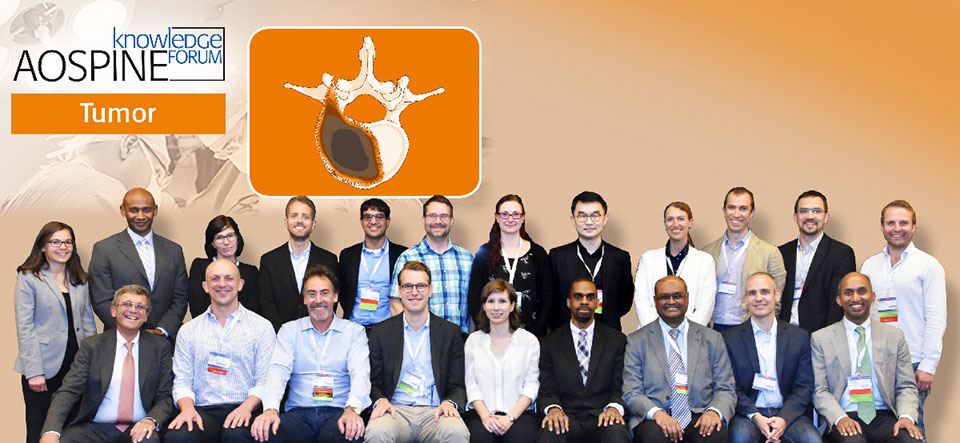
AOSpine KF Tumor meeting during the Global Spine Congress in Singapore, May 2018
Improving spine cancer patients' quality of life—AOSpine validates the first spine oncology-specific patient-reported outcome measure
Health-related quality of life (HRQOL) questionnaires can be used to monitor a patient’s general health status, a hospital's performance as a healthcare provider, or even an entire population’s health over time. They can also help patients to understand what to expect with treatment. Until now, there has been nothing specific to measure the quality of life of people with spine oncology problems. To fill the need, the AOSpine Knowledge Forum (KF) Tumor validated and adapted the questionnaire. Using this tool, they will look for predictive factors and explore patient expectations, so that the questionnaire will not only evaluate, but serve to improve spine cancer patient’s quality of life.
“This is quite an impactful accomplishment and a particularly challenging population to validate psychometrically”, Principal Investigator (PI) Charles Fisher explains. “Like any “It allows us to test our interventions to make sure the patient is improving.”outcome instrument, it allows us to test our interventions—be it radiation, medical, or surgical—to make sure the patient is improving. It will make us more confident in the evaluation of our interventions.”
The paper was published in Cancer* this Spring. Lead author, Anne Versteeg stresses the validated Spine Oncology Study Group Outcomes Questionnaire (SOSGOQ2.0) is a reliable measure and encourages clinicians to incorporate it into their practice. “We should use it in the spine oncology population to evaluate which patients are improving and who don't.” Her advice is to use it in combination with a generic instrument, such as EQ-5D, SF-36, or PROMIS, so that it is easy to compare results to other studies and pathologies.
“Importantly, with the SOSGOQ2.0, we could see differences between patients within the population, which is what you want. Seriously disabled patients have lower scores compared to those who are doing better. With the SOSGOQ2.0, you can see the “By combining patient characteristics and outcomes, we would like to be able to predict if a patient has a good chance of improving their quality of life or not.”differences between them.”
EPOSO, the international, multicenter, prospective, observational study enrolled a diverse cohort of 238 patients with spinal metastases, including patients who underwent surgery and radiation therapy alone. The Cancer article stood out to the AOSpine Europe's Young Researcher Award judges, and Versteeg was awarded first place to support the translation of the questionnaire into different languages and to determine what constitutes a meaningful change for a patient. The research also won Best Paper Award at the 30th European Musculo-Skeletal Oncology Society meeting (EMSOS2017).

 Anne Versteeg presenting the award-winning study at the Global Spine Congress 2018 in Singapore, May 2018Charles Fisher and Anne Versteeg proud to launch the new disease-specific patient-reported outcome measure for Spine Cancer Patients1 - 2<>
Anne Versteeg presenting the award-winning study at the Global Spine Congress 2018 in Singapore, May 2018Charles Fisher and Anne Versteeg proud to launch the new disease-specific patient-reported outcome measure for Spine Cancer Patients1 - 2<>
A framework for future studies
The SOSGOQ2.0 provides a framework for further studies. These include: economic evaluations, to develop an oncology utility; to assess patient expectations; to determine factors that are linked with improvement of quality of life after treatment; and to measure patient satisfaction.
KF Tumor wants to find out which patients respond well to treatment and which do not and plans to use this new tool to search for predictive factors. “By combining patient characteristics and outcomes, we would like to be able to predict if a patient has a good “We are exploring also patient satisfaction with this tool.”chance of improving their quality of life or not. For these patients, it's really about quality of life and how to improve their quality of life for their remaining time”, Versteeg says.
The study group is further exploring patient satisfaction with this tool. In general, patients should be satisfied with their treatment. But as Versteeg points out, satisfaction is based on personal experience and expectations, which makes it difficult to measure. “Sometimes the patient can improve, but if they are not satisfied, that's also important to know. If they undergo an invasive surgical procedure and have to stay in hospital for weeks with a life “It is equally important to continue to do studies using the instrument, to publish, and to present results at both spine meetings and cancer meetings, so that people know it is out there and see it is used.”expectancy of six months and they are not satisfied with the outcome … that's pretty harsh.”
The questionnaire is currently being validated in Hungarian and Dutch, it has been translated into German, and external parties have expressed interest to translate it into Thai and Russian. Fisher wants to see the SOSGOQ2.0 become the standard outcome measure for evaluating interventions in spine oncology. A broad working group including other disciplines—such as pain doctors and oncologists from outside AO—would stimulate general acceptance; other professional societies' endorsement would support finding consensus and development of universal guidelines. “It is equally important to continue to do studies using the instrument, to publish, and to present results at both spine meetings and cancer meetings, so that people know it is out there and see it is used.”
This AOSpine sponsored study has been performed with AO Clinical Investigation and Documentation.
Download the patient-reported outcomes questionnaire SOSGOQ2.0 www.aospine.org ![]()
* Versteeg AL, Sahgal A, Rhines LD, Sciubba DM, Schuster JM, Weber MH, Varga PP, Boriani S, Bettegowda C, Fehlings MG, Clarke MJ, Arnold PM, Gokaslan ZL, Fisher CG, AOSpine KF Tumor. Psychometric evaluation and adaptation of the Spine Oncology Study Group Outcomes Questionnaire to evaluate health-related quality of life in patients with spinal metastases. Cancer 124(8): 1828-1838, 2018.
Read the full open access article in Cancer doi.org ![]()
More information on KF Tumor www.aospine.org/kf-tumor ![]()
Newsletter 17 | July 2018
Newsletter 17
July 2018
feature storIES